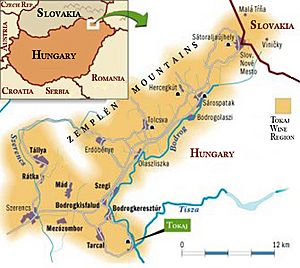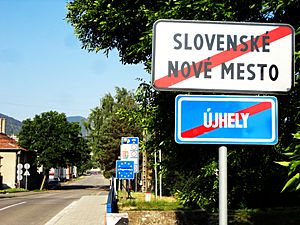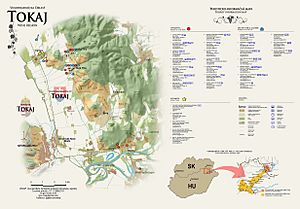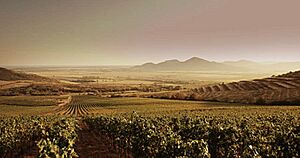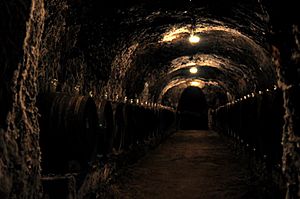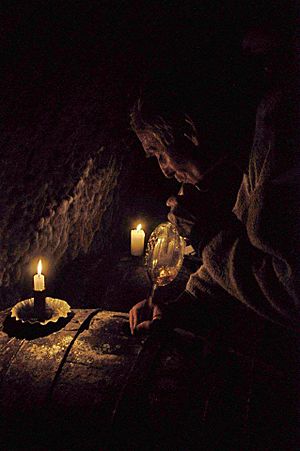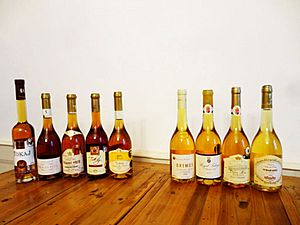Tokaj (Slovakia) facts for kids
| Wine region | |
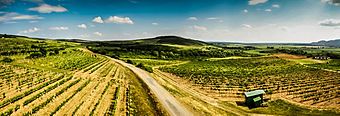 |
|
| Official name | Vinohradnícka oblasť Tokaj |
|---|---|
| Country | Slovakia, Hungary |
| Climate region | Continental climate |
| Precipitation (annual average) | 550 mm |
| Soil conditions | rocky with volcanic origin |
| Total area | 908,11 ha |
| Grapes produced | Furmint, Lipovina, Muškát žltý, Zéta |
| Varietals produced | Tokaji |
| No. of wineries | Tokaj Regnum Association |
The Tokaj wine region (Slovak: Vinohradnícka oblasť Tokaj) is a special area where grapes are grown for making wine. It is found in both south-eastern Slovakia and north-eastern Hungary. This region was once a single, larger area known as the Tokaj-Hegyalja wine region.
After a big peace agreement called the Treaty of Trianon in 1920, the region was split. A small part became part of Czechoslovakia, which is now Slovakia. The larger part stayed with Hungary.
Today, the Slovakian side of the Tokaj wine region includes 7 villages. It has about 908 hectares (about 2,244 acres) of vineyards. Because of special rules in Europe, winemakers in the Slovak Tokaj region can still use the name "Tokaj" for their wines.
Contents
History of the Tokaj Wine Region
Grape growing in the Tokaj region started a very long time ago. It began when the Roman Empire ruled this area. After the Roman Empire ended, Slavic people continued the tradition. Many believe the name "Tokaj" comes from a Slavic word meaning "where two rivers meet." This refers to the Bodrog and Tisza rivers.
Early Beginnings and Legends
A legend says that when Hungarians arrived, led by Árpád, grape growing was already popular. Árpád's knight, Turzol, found hills covered in vineyards. Árpád then gave Turzol the hill and the land near the rivers. This is where the village of Turzol (now Tarcal) was built.
In 1241, invaders called the Tatars attacked the area. They destroyed many vineyards. King Béla IV of Hungary wanted to rebuild the region. He invited new people, possibly from France or Italy, to settle there.
New Settlers and Wine Cellars
Some Italian settlers came to the village of Bara. They brought new skills for growing grapes and making wine. They also brought a grape type called Furmint. Later, the region was under Turkish rule for 170 years. Many of the old Tokaj wine cellars were built during this time. People used them to hide from soldiers.
Around 1620, an emperor brought a French wine farmer named Duvont. He created a special method for making the famous "king of wines" in Tokaj. The emperor was so impressed that he honored Duvont and his family.
The Rise of Tokaji Wine
Tokaji wine became very important from the 1600s. Selling this wine brought a lot of money to the region's rulers. This money even helped them fight for independence. In 1703, a prince gave some Tokaji wine to King Louis XIV of France. The king loved it and called it "Wine of Kings, King of Wines."
In the 1700s, Tokaj was very successful. Countries like Poland and Russia bought a lot of its wine. Russian emperors even had a special group in Tokaj to make sure they always had wine for their court.
Challenges and Changes
Later, new taxes made it harder to sell Tokaji wine. Then, in 1885, a disease called phylloxera destroyed most of the vineyards. This was a very difficult time for the region.
How Tokaj-Hegyalja Was Divided
After the Treaty of Trianon in 1920, Hungary lost much of its land. The Tokaj wine region was split between Hungary and the new country of Czechoslovakia. A small part of a Hungarian town became a new village in Czechoslovakia called Slovenské Nové Mesto.
Czechoslovakia gained about 175 hectares of vineyards and 3 villages: Malá Tŕňa, Slovenské Nové Mesto, and Viničky. Malá Tŕňa was the main wine-growing village in this new Slovakian part. It even had a school for wine growing.
Changes Over Time
In 1959, the Czechoslovak government added 4 more villages to the Tokaj wine region. These were Veľká Tŕňa, Bara, Čerhov, and Černochov. This made the total area of classified Tokaj vineyards larger. In 1996, the area grew again to 908.11 hectares.
A detailed map of the Slovakian Tokaj wine region was made in 2016. You can see it on tourist signs in the area.
Special Features of the Tokaj Wine Region
The Tokaj wine region is one of the few places in the world perfect for making naturally sweet wines. It is the smallest of Slovakia's six wine-growing regions. It includes 7 villages in the Trebišov District.
Here are some things that make the Tokaj wine region special:
- Soil and Weather: The soil in Tokaj is clay or loess, sitting on volcanic rock. The weather is unique because of sunny, south-facing hills and nearby rivers. This climate helps a special mold called Botrytis Cinerea grow on the grapes. This mold helps dry the grapes, making them sweeter.
- Local Grapes: Grapes like Furmint and Lipovina have grown here for hundreds of years. Along with Yellow Muscat and Zeta, these are the only grapes allowed for Tokaj wines.
- Wine Cellars:
There is a huge network of cellars carved into the solid rock. These cellars stay at a constant cool temperature (around 12°C or 54°F). They also have high humidity. These conditions are perfect for aging Tokaji wines.
- Wine Rules: In 1757, a royal rule created the world's first system for wine regions. This meant that only wines from this specific area could be called "Tokaj." Vineyards were officially classified in the 1700s.
Winemakers and Wine Types
Winemakers on the Slovakian side of the border make both sweet dessert wines and dry wines. These wines are similar to those made in the Hungarian part of the region.
Tokaj wines (Slovak: Tokajské víno) are made only from three main grape types: Furmint, Lipovina, and Yellow Muscat (Template:Slovak language: Muškát žltý). Some of the different types of Tokaj wines include:
- Tokajský Furmint
- Tokajská Lipovina
- Tokajský Muškát žltý (Yellow Muscat)
- Tokajské samorodné suché: This means "dry, as it grew." It is made from grape bunches that have some grapes with the special mold.
- Tokajské samorodné sladké: This means "sweet, as it grew." It is also made from bunches with a larger amount of moldy grapes.
- Tokajský výber (in Hungarian: aszú): This is the famous sweet dessert wine. It is made by carefully picking grapes with the special mold. These grapes are crushed into a paste. Then, grape juice is poured over the paste and left to soak. The wine then ages in wooden barrels. These wines are graded by how much sugar they have, from 3 to 6 putňa.
- Tokajská výberová esencia (the Hungarian version is called aszú-eszencia)
- Tokajská esencia-nektár (meaning "essence-nectar")
- Tokajský mášláš (from the Hungarian word máslás)
- Tokajský fordítáš (from the Hungarian word fordítás)
The "Tokaj" Name Dispute
Tokaj wine is special and popular around the world. Because of this, there has been a disagreement about who can use the "Tokaj" name.
The problem started in 1964 when Czechoslovakia began selling its Tokaj wine to Austria. Before this, only Hungary sold Tokaj wine there. The two countries made an agreement. Slovakia could only sell its extra Tokaj wine to Hungary, which would then re-sell it.
This agreement ended in 1990, and the dispute began again. In 2012, a European court ruled that Slovakia could keep its "Vinohradnícka oblasť Tokaj" (Tokaj Wine Region) name in a European database. Hungary tried to appeal this decision, but in 2013, the court said no.
This means that under current European rules, the Tokaj wine region is officially in both Hungary and Slovakia. So, winemakers from both countries can use the "Tokaj" name for their wines.


